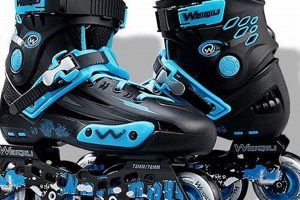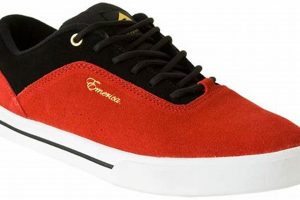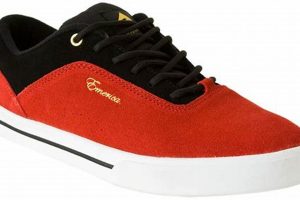Protective footwear specifically designed for children participating in skateboarding activities provides the necessary support and resilience. These items typically feature reinforced construction, durable outsoles for grip, and cushioning for impact absorption. For instance, a child learning to ollie may benefit from footwear with enhanced ankle support and a vulcanized rubber sole for board feel.
Proper footwear can significantly reduce the risk of injuries associated with skateboarding, allowing young participants to develop their skills with greater confidence. Historically, the evolution of such footwear has mirrored the advancements in skateboarding itself, with manufacturers continually innovating to meet the demands of increasingly complex tricks and maneuvers. This has led to improvements in durability, comfort, and performance, contributing to a safer and more enjoyable experience for young skaters.
The following sections will delve into the specific features to consider when selecting appropriate protective footwear, including materials, construction methods, and sizing considerations. Additionally, this information will address the different types of footwear available and provide guidance on maintenance and care.
Guidance on Selecting Footwear for Young Skateboarders
Choosing the correct footwear is paramount for young skateboarders, impacting both performance and safety. Consider the following recommendations to ensure an appropriate selection.
Tip 1: Prioritize Durability: Examine the materials used in construction. Suede or leather uppers offer superior resistance to abrasion, a common occurrence during skateboarding. Reinforcements in high-wear areas, such as the toe and ollie patch, are critical.
Tip 2: Evaluate Sole Construction: Vulcanized soles provide enhanced board feel and flexibility, enabling better control. Cupsole constructions offer greater impact protection, beneficial for skaters performing more demanding tricks. Select the appropriate sole type based on the skater’s skill level and style.
Tip 3: Assess Ankle Support: High-top designs offer increased ankle stability, reducing the risk of sprains and other injuries. Consider mid-top or low-top styles for skaters prioritizing flexibility and freedom of movement, but be mindful of the reduced support.
Tip 4: Consider Cushioning: Insoles with adequate cushioning absorb impact and minimize stress on joints. Look for features such as molded footbeds or gel inserts for enhanced comfort during extended skateboarding sessions.
Tip 5: Ensure Proper Fit: Ill-fitting footwear can lead to blisters, discomfort, and impaired performance. Measure the child’s foot accurately and consult sizing charts provided by the manufacturer. Allow for a small amount of room for growth, but avoid excessively large sizes that can compromise stability.
Tip 6: Examine Tread Pattern: A grippy tread pattern is essential for maintaining contact with the skateboard. Look for patterns with deep grooves and durable rubber compounds for optimal traction on various surfaces.
Tip 7: Inspect Lacing System: A secure lacing system prevents the footwear from loosening during use, enhancing stability and control. Consider features such as recessed eyelets or lace protectors to minimize wear and tear on the laces.
By adhering to these guidelines, parents and guardians can confidently select protective footwear that supports young skateboarders’ development and reduces the risk of injury.
The subsequent section will address specific brands and models known for their quality and performance, further aiding in the selection process.
1. Durability
The durability of skateboarding footwear intended for children is a critical factor influencing both the longevity of the product and the safety of the user. The abrasive nature of skateboarding subjects the footwear to significant wear and tear, particularly in areas such as the toe, ollie patch, and sole. Consequently, the material composition and construction techniques employed directly impact the footwear’s ability to withstand these forces. Insufficient durability leads to premature failure of the footwear, requiring frequent replacement and potentially exposing the child to increased risk of injury due to compromised structural integrity. For instance, a skateboarding shoe with a poorly constructed sole may separate from the upper after only a few sessions, rendering the shoe unusable and unsafe.
Manufacturers enhance the durability of children’s skateboarding footwear through various methods. Reinforced stitching, the use of abrasion-resistant materials like suede or leather, and the implementation of protective overlays in high-wear areas are common strategies. The type of sole construction also plays a significant role. Vulcanized soles, while offering enhanced board feel, may be less durable than cupsole constructions, which provide greater impact absorption and structural support. Therefore, selecting footwear with appropriate construction for the intended usage and skill level is essential. Shoes intended for aggressive street skating, for example, require significantly more durable construction than those used primarily for recreational cruising.
In summary, the durability of skateboarding footwear for children is not merely a matter of cost-effectiveness, but a safety imperative. The selection of durable materials, reinforced construction, and appropriate sole types directly contributes to the longevity of the footwear and the protection afforded to the young skater. Failure to prioritize durability can result in premature wear, compromised safety, and increased financial burden on the consumer. Further research into specific materials and construction techniques can provide more detailed guidance on selecting durable and reliable skateboarding footwear for children.
2. Grip
Grip, concerning skateboarding footwear for children, directly influences board control, stability, and overall safety. The interaction between the shoe’s outsole and the skateboard deck dictates the user’s ability to maintain balance and execute maneuvers. Adequate grip is paramount for preventing slips and falls, particularly during dynamic movements inherent in skateboarding.
- Outsole Material Composition
The specific rubber compound used in the outsole directly affects its coefficient of friction. Softer rubber compounds generally offer superior grip compared to harder, more durable alternatives. However, softer compounds tend to wear down more quickly. Manufacturers must strike a balance between grip and durability to optimize performance. For instance, a child learning to perform a kickflip requires a high degree of grip to maintain foot placement on the board during the trick’s execution.
- Tread Pattern Design
The tread pattern’s design influences the contact area between the outsole and the skateboard deck, thereby affecting grip. Patterns with deep grooves and multidirectional sipes enhance grip by channeling away water and debris, maximizing surface contact. A well-designed tread pattern improves traction in various conditions, ensuring a secure connection between the footwear and the skateboard. Example tread patterns include herringbone, waffle, and geometric variations, each with specific advantages and disadvantages regarding grip and wear resistance.
- Sole Flexibility
The flexibility of the sole impacts its ability to conform to the concave shape of the skateboard deck, maximizing contact and enhancing grip. A sole that is too rigid will reduce the contact area, diminishing grip and potentially leading to instability. More flexible soles allow the skater to feel the board more effectively, increasing control and responsiveness. This is particularly relevant for technical skateboarding where subtle adjustments are critical.
- Surface Texture
The surface texture of the outsole contributes to the overall grip. A rough or textured surface increases friction compared to a smooth surface. Texturing can be achieved through various methods, including molding specific patterns into the rubber or applying a coating to enhance grip. Over time, the texture may wear down, reducing grip effectiveness. Regular cleaning and maintenance can help prolong the lifespan of the outsole texture.
In conclusion, grip is a multifaceted characteristic of youth skateboarding footwear, determined by outsole material, tread pattern, sole flexibility, and surface texture. These elements collectively dictate the skater’s ability to maintain control and stability on the board. Compromised grip can significantly increase the risk of falls and injuries. Selecting appropriate footwear, therefore, necessitates careful consideration of these factors to ensure optimal performance and safety for young skateboarders. Understanding the nuanced interplay of these grip-related characteristics allows for informed purchasing decisions and contributes to a safer, more enjoyable skateboarding experience.
3. Support
Skeletal and muscular support is a critical consideration in footwear designed for children participating in skateboarding. The repetitive impacts and unnatural angles encountered in the activity place significant stress on developing joints and bones. Adequate support within the footwear mitigates the risk of injuries and promotes proper biomechanical alignment.
- Ankle Stability
The ankle joint is particularly vulnerable to sprains and strains during skateboarding. Footwear with enhanced ankle support, such as high-top designs or reinforced collars, reduces the likelihood of these injuries. The support limits excessive lateral movement, preventing the ankle from rolling or twisting. A young skater attempting a backside 180, for example, relies on ankle stability to maintain balance and control upon landing.
- Arch Support
Proper arch support is essential for distributing weight evenly across the foot and preventing overpronation or supination. Footwear with inadequate arch support can lead to foot fatigue, plantar fasciitis, and other related conditions. A molded insole or orthotic insert provides the necessary support to maintain the foot’s natural arch, reducing strain on the plantar fascia and supporting ligaments. This is especially important for children with flat feet or high arches.
- Heel Counter Reinforcement
The heel counter, the rigid structure surrounding the heel, provides stability and prevents excessive heel movement within the footwear. A reinforced heel counter enhances support and helps maintain proper alignment of the foot and ankle. This feature is particularly important for preventing heel slippage and ensuring a secure fit. During high-impact landings, a reinforced heel counter absorbs and distributes forces, reducing stress on the heel and ankle joints.
- Midsole Cushioning
The midsole, located between the outsole and the insole, provides cushioning and shock absorption. A well-cushioned midsole reduces the impact forces transmitted to the foot, ankle, and knee joints during skateboarding. Materials such as EVA foam or polyurethane are commonly used in midsoles to provide cushioning and support. Adequate midsole cushioning minimizes joint stress and reduces the risk of overuse injuries. A child repeatedly practicing ollies will benefit from the impact absorption provided by a cushioned midsole.
The interplay of these supportive elements within skateboarding footwear directly impacts the safety and performance of young skaters. Prioritizing footwear with adequate ankle stability, arch support, heel counter reinforcement, and midsole cushioning minimizes the risk of injuries and promotes proper biomechanical function. Careful consideration of these factors is essential when selecting appropriate skateboarding footwear for children.
4. Comfort
Comfort, in the context of skateboarding footwear for children, extends beyond mere pleasantness; it is a functional element directly impacting performance, safety, and long-term foot health. Ill-fitting or uncomfortable footwear can lead to distractions, reduced focus, and altered biomechanics, increasing the risk of falls and injuries. Consider a child attempting a complex trick while experiencing discomfort due to friction or inadequate cushioning; the resulting distraction can compromise their balance and increase the likelihood of a fall. Prolonged use of uncomfortable footwear can also contribute to foot problems such as blisters, calluses, and even musculoskeletal issues that may affect development.
The design of comfortable youth skateboarding footwear necessitates consideration of several key factors. Proper fit is paramount, requiring accurate measurement and adherence to sizing guidelines. Materials play a significant role; breathable fabrics minimize moisture buildup, reducing the risk of friction and irritation. Ample cushioning, strategically placed in areas of high impact, absorbs shocks and minimizes stress on joints. The internal construction should be free of abrasive seams or pressure points that could cause discomfort or blisters. Practical application of these principles is evident in the selection of designs featuring molded insoles, padded collars, and lightweight construction, all aimed at enhancing the wearer’s comfort during extended use. The material also affects comfortability for example, using leather type materials can allow foot to breathe more comfortably.
In summary, the relationship between comfort and skateboarding footwear for children is inextricable. Comfortable footwear enhances focus, supports proper biomechanics, and minimizes the risk of both acute injuries and long-term foot problems. Challenges remain in balancing comfort with other performance-related factors such as durability and board feel; however, prioritizing comfort through thoughtful design and material selection is essential for promoting a safe and enjoyable skateboarding experience for young participants. This understanding also highlights the importance of informed purchasing decisions, emphasizing the long-term benefits of investing in well-designed, comfortable skateboarding footwear.
5. Protection
Protective attributes of skateboarding footwear for children are critical for mitigating the inherent risks associated with the activity. These risks include impacts, abrasions, and potential ankle or foot injuries. The footwear must, therefore, provide adequate safeguarding without compromising performance or comfort.
- Impact Absorption
Impact absorption refers to the footwear’s capacity to dissipate forces generated during landings and other high-impact maneuvers. Midsoles constructed from materials like EVA foam or polyurethane provide cushioning and reduce stress on joints. For instance, a skater landing an ollie exerts considerable force on the feet and ankles. Effective impact absorption minimizes the risk of stress fractures and other impact-related injuries.
- Abrasion Resistance
Skateboarding involves repeated contact with abrasive surfaces, such as concrete or asphalt. The uppers of skateboarding footwear are subjected to significant wear and tear. Materials like suede, leather, or reinforced synthetics offer increased abrasion resistance, prolonging the lifespan of the footwear and protecting the foot from scrapes and cuts. A reinforced toe cap, for example, prevents premature wear in a high-abrasion area.
- Ankle and Foot Support
Protection also extends to providing adequate support to the ankle and foot. High-top designs or reinforced ankle collars offer additional stability, reducing the risk of ankle sprains. Internal heel counters prevent excessive heel movement, minimizing friction and improving overall support. Proper arch support helps distribute weight evenly across the foot, preventing fatigue and reducing the risk of plantar fasciitis.
- Reinforced Construction
The overall construction of the footwear contributes to its protective capabilities. Reinforced stitching, double-layered materials in high-stress areas, and durable sole adhesion enhance the footwear’s ability to withstand the forces encountered during skateboarding. A well-constructed skateboarding shoe maintains its structural integrity, providing consistent protection throughout its lifespan.
The various facets of protection in skateboarding footwear for children are interconnected and contribute to a comprehensive safety system. Effective impact absorption, abrasion resistance, ankle and foot support, and reinforced construction work in concert to minimize the risk of injuries. Prioritizing these protective attributes when selecting footwear is crucial for ensuring a safe and enjoyable skateboarding experience for young participants. Moreover, advancements in materials and construction techniques continually enhance the protective capabilities of these specialized shoes.
Frequently Asked Questions
This section addresses common inquiries regarding specialized footwear for young skateboarders, clarifying misconceptions and providing essential information.
Question 1: What distinguishes skateboarding footwear from regular athletic footwear?
Skateboarding footwear exhibits distinct construction features, including reinforced uppers for abrasion resistance, vulcanized or cupsole construction for enhanced board feel and impact absorption, and specialized tread patterns for superior grip. Regular athletic footwear typically lacks these skateboarding-specific design elements.
Question 2: How does sole construction affect skateboarding performance?
Vulcanized soles offer increased flexibility and board feel, beneficial for experienced skaters requiring precise control. Cupsole construction provides superior impact protection, suitable for beginners or skaters performing high-impact tricks. The selection of sole construction depends on skill level and preferred skating style.
Question 3: What materials are recommended for skateboarding footwear uppers?
Suede and leather are favored materials due to their durability and resistance to abrasion. Synthetic materials, often reinforced with additional layers, offer comparable performance and may provide enhanced breathability. The choice of material depends on desired balance between durability, breathability, and cost.
Question 4: How should skateboarding footwear fit to ensure both comfort and safety?
Skateboarding footwear should fit snugly, allowing minimal movement within the shoe. Adequate toe room is essential to prevent discomfort or injury. The heel should be securely held to minimize slippage. A professional fitting is recommended to ensure proper sizing.
Question 5: How frequently should skateboarding footwear be replaced?
The lifespan of skateboarding footwear depends on the frequency and intensity of use. Visual indicators of wear, such as sole separation, fabric tears, or diminished tread, indicate the need for replacement. Regularly inspecting footwear is crucial to maintaining safety and performance.
Question 6: Can skateboarding footwear be used for other activities?
While skateboarding footwear can be used for general casual wear, its specialized construction may not be optimal for other athletic activities. The reinforced construction and stiffer soles can limit flexibility and comfort during running or other sports requiring diverse movement patterns.
Proper footwear is essential for young skateboarders’ safety and skill progression. Selecting the right footwear considering its grip, protection, support, and protection ensures they will enjoy the activity and prevent injuries.
The following section delves into the care and maintenance of children’s skateboarding footwear, prolonging its lifespan and preserving its protective properties.
Conclusion
This exploration of kids skate shoes has illuminated crucial aspects pertaining to safety, performance, and durability. Considerations ranging from outsole grip and ankle support to material abrasion resistance directly impact the young skater’s experience. The selection of appropriate footwear demands careful evaluation, transcending mere aesthetic preferences.
Prioritizing the quality and suitability of skateboarding footwear is an investment in the child’s well-being and fosters responsible participation in the sport. Continued research and development in footwear technology will likely yield further enhancements in protection and performance, underscoring the enduring significance of this equipment.


![Find Your Fit: Most Comfy Skate Shoes Reviewed [Guide] Safem Fabrication - Precision Engineering & Custom Manufacturing Solutions Find Your Fit: Most Comfy Skate Shoes Reviewed [Guide] | Safem Fabrication - Precision Engineering & Custom Manufacturing Solutions](https://cruzskateshop.com/wp-content/uploads/2025/06/th-3365-300x200.jpg)

![Best Inline Skate Shoes of [YEAR]: Reviews & Guide Safem Fabrication - Precision Engineering & Custom Manufacturing Solutions Best Inline Skate Shoes of [YEAR]: Reviews & Guide | Safem Fabrication - Precision Engineering & Custom Manufacturing Solutions](https://cruzskateshop.com/wp-content/uploads/2025/06/th-3318-300x200.jpg)


